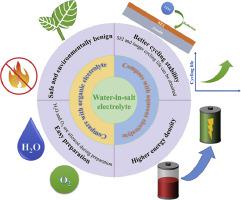Energy Storage Materials ( IF 20.4 ) Pub Date : 2020-10-14 , DOI: 10.1016/j.ensm.2020.10.011 Yuanhao Shen , Bin Liu , Xiaorui Liu , Jie Liu , Jia Ding , Cheng Zhong , Wenbin Hu

|
As one of the most promising energy storage systems, conventional lithium-ion batteries based on the organic electrolyte have posed challenges to the safety, fabrication, and environmental friendliness. By virtue of the high safety and ionic conductivity of water, aqueous lithium-ion battery (ALIB) has emerged as a potential alternative. Whereas, the narrow electrochemical stability window (ESW) of water severely restricts the performance of ALIB. In recent years, with the introduction of water-in-salt electrolyte (21 mol LiTFSI in 1 kg H2O), the ESW of aqueous electrolyte was expanded to ~3 V, which significantly improved the voltage and energy density of ALIBs. Nevertheless, in view of such high salt concentration, water-in-salt electrolyte will dramatically increase the cost of ALIBs. Hence, due to their lower cost and abundant resource, aqueous sodium-ion batteries and zinc-based batteries show great potential. Herein, the latest advances of water-in-salt electrolyte in aqueous rechargeable batteries are briefly reviewed. Some challenges and prospects of water-in-salt electrolyte are also discussed to broaden the horizons for future development.
中文翻译:

盐包水电解质,用于安全高能的水性电池
作为最有前途的储能系统之一,基于有机电解质的常规锂离子电池已经对安全性,制造和环境友好性提出了挑战。由于水的高安全性和离子电导率,水性锂离子电池(ALIB)已经成为一种潜在的替代品。然而,狭窄的水电化学稳定性窗口(ESW)严重限制了ALIB的性能。近年来,随着盐包水电解质的引入(在1 kg H 2中使用21 mol LiTFSIO),水性电解质的ESW扩大到〜3 V,这显着提高了ALIBs的电压和能量密度。然而,鉴于如此高的盐浓度,盐包水电解质将大大增加ALIB的成本。因此,由于其较低的成本和丰富的资源,水性钠离子电池和锌基电池显示出巨大的潜力。在此,简要回顾水性充电电池中的盐包水电解质的最新进展。还讨论了盐包水电解质的一些挑战和前景,以拓宽未来的发展前景。


























 京公网安备 11010802027423号
京公网安备 11010802027423号